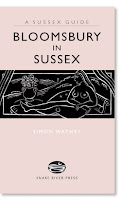Book review: Bloomsbury in Sussex
 By Simon Watney
By Simon WatneyIllustrated by Barbara Childs
Published by Snake River Press
With its pale rose cover and elegant layout, the sixth volume in the Snake River Press series “Books About Sussex for the Enthusiast” is dedicated to Bloomsbury in Sussex.
Bloomsbury is normally associated with London but the members of the celebrated group of artists, writers and thinkers were also very fond of the rural landscape of the South Downs and enjoyed the freedom that living in the country allowed them.
In this resourceful guide, Simon Watney provides an overview of the Modernist group before delving deep in what you could call its “Sussex heritage” – from Virginia Woolf’s homes in Firle and Asheham, which helped her form a strong bond with Sussex, to Monk’s House, in Rodmell, where she lived with her husband Leonard until her death. The tour continues with the Charleston farmhouse, home to Vanessa Bell and Duncan Grant and, perhaps, the most famous meeting place of Bloomsbury in Sussex and, last but not least, the beautiful Berwick Church, whose murals were painted by the two artists in 1941.
The book comes complete with short biographies of the key members of the group, which highlight the relationships between them. There are also extremely informative descriptions of the works of art and elements of interior design that can be found at Berwick Church, Monk’s House and Charleston. They are all open to the public, the latter two being managed by the National Trust.
The detailed explanations and the interesting insight into the domestic lives of Virginia Woolf and her contemporaries, cleverly dispersed with quotes from their letters and diaries, have certainly enriched my visits and gave me a real understanding of the Bloomsbury-Sussex connection.


Comments
Post a Comment